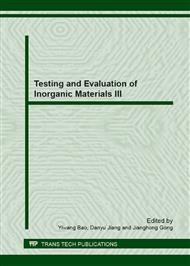p.120
p.124
p.128
p.135
p.139
p.144
p.148
p.152
p.156
Effects of Sol Network Modifiers on Preparation, Morphology and Phase Composition of Zirconium Diboride Nano-Powders by Novel Sol-Gel Technology
Abstract:
Zirconium diboride nano-powders were synthesized by novel sol-gel technology using zirconium oxychloride, boric acid and sucrose as row materials. Different sol network modifiers, such as propylene oxide (PO) and citric acid (CA), were used to control the formation of zirconia precursor sol, respectively. PO could stabilize the sol by protonation and ring-opening reactions, and CA could form the sol network by chelation, then transformed to gel network. Gel was dried, ground, and exposed to carbonthermal reduction heat treatment (1500°C, 2h, flowing 95%argon mix with 5% hydrogen) to prepare ZrB2 nano-powders. In this study, effects of sol network modifiers on preparation procedure, powder characteristics were performed by using Infrared spectroscopy (FTIR), X-ray diffraction (XRD) and Transmission electron microscopy (TEM). The purity of ZrB2 will improve by increasing the molar ratio of B/Zr, the photomicrograph revealed nearly pure ZrB2 nano-powders with spherical shape of 50-200nm and well dispersed were obtained with a molar ratio of B/Zr of 3.0 at 1500°C for 2h using PO as chemical modifier.
Info:
Periodical:
Pages:
139-143
Citation:
Online since:
March 2013
Authors:
Keywords:
Price:
Сopyright:
© 2013 Trans Tech Publications Ltd. All Rights Reserved
Share:
Citation:


